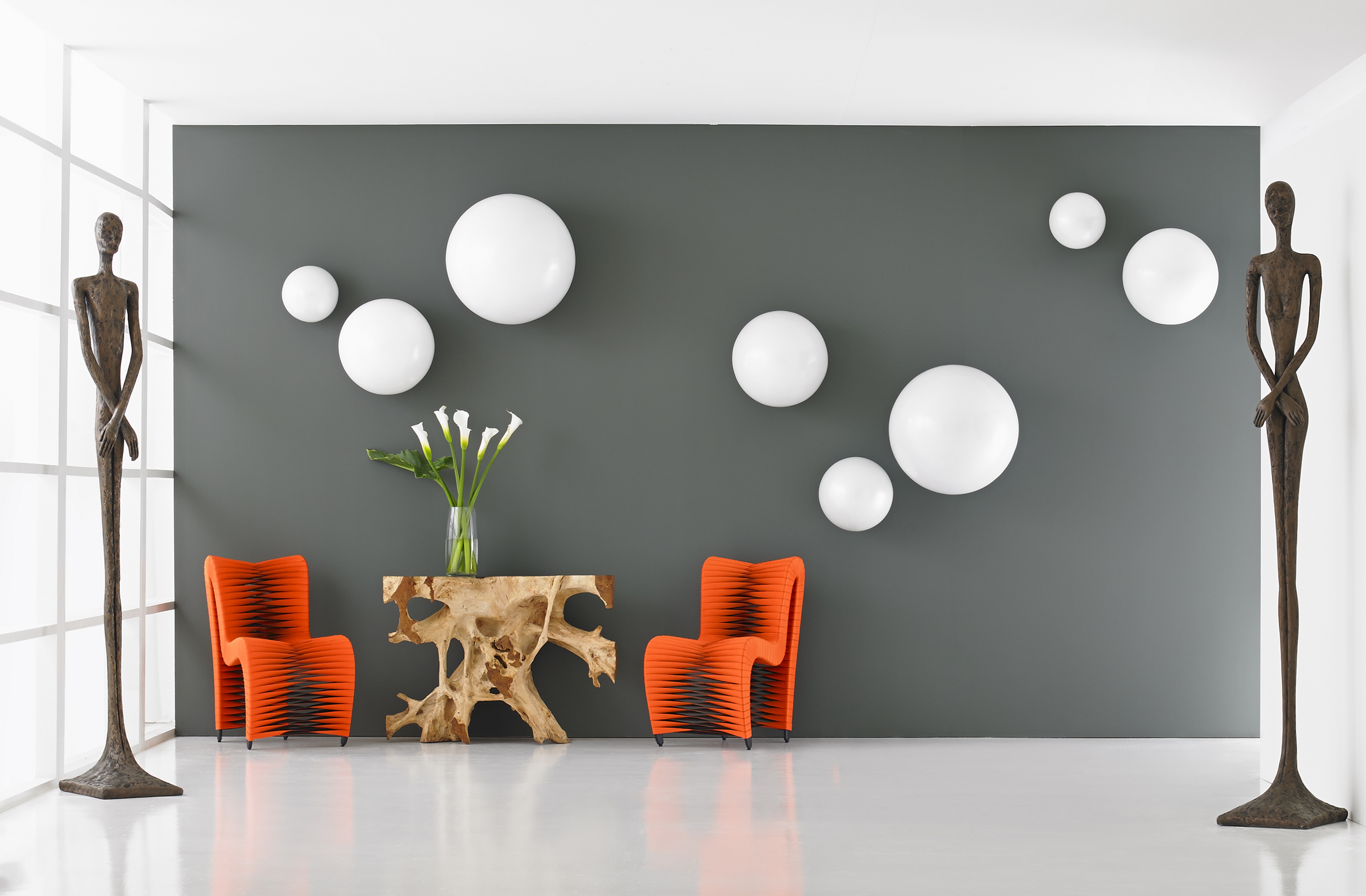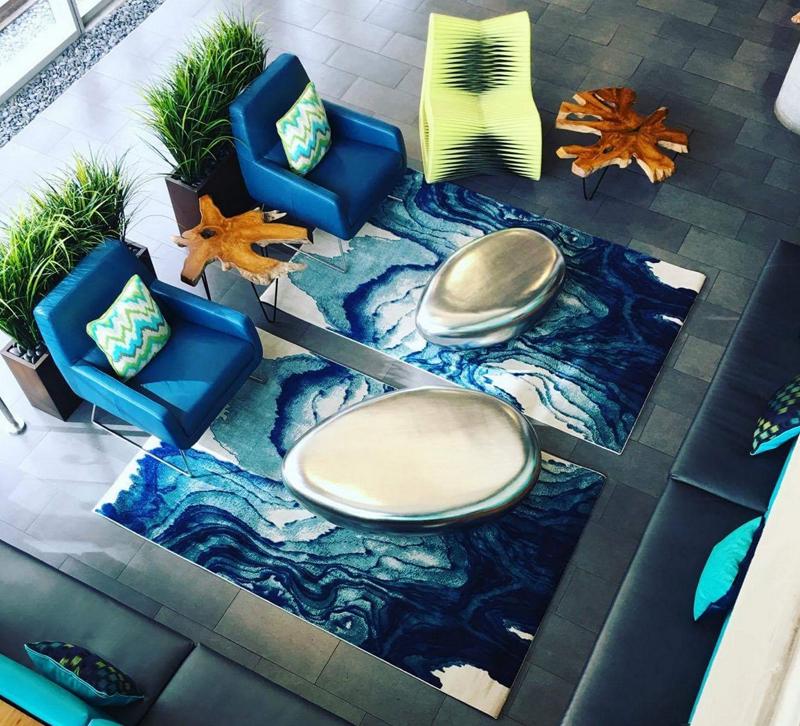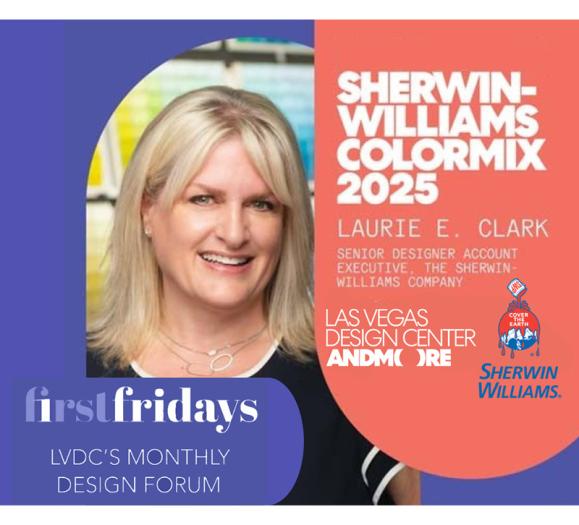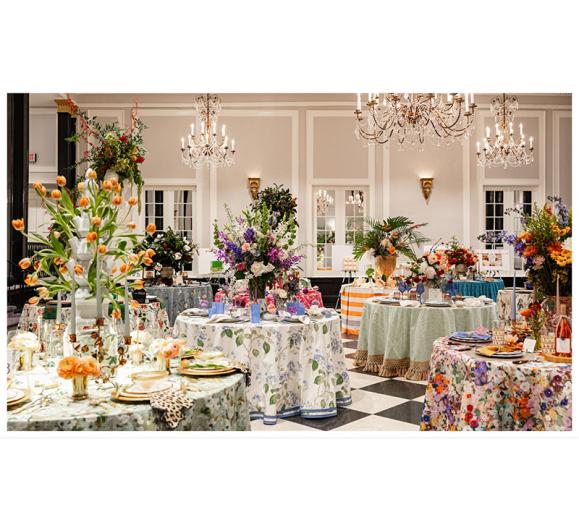While the lines between the contract, hospitality and residential design businesses were long well-defined — some might say stark — Amanda Schneider, President of Contract Consulting Group — a research-led strategy firm serving the contract interiors market — points to the growing presence of specialty retailers like Crate & Barrel and Restoration Hardware at contract shows and says, “There’s no such thing as a clear-cut vertical anymore in design or distribution. It’s a very confusing time.”
Astute trendwatchers on the residential side would no doubt agree, citing as prime example the Hospitality at Market program launched two years ago by the High Point Market Authority as an annual project created to recruit hospitality designers and buyers to the world’s home for home furnishings.
Just last month, International Market Centers cut the ribbon on HD Studio. Located on the top floor of the Suites at Market Square, it was an exhibit featuring a new collective of hospitality brands and products that was also home to the Hospitality Hub, an information center designed to help the hospitality and contract trade take advantage of all the home furnishings market has to offer. For those who may have missed it, the list of exhibitors showcasing their hospitality chops included names like Culp, Euro Style, Belle Meade, Phillips Collection and Global Views. This month, a quick scan of the exhibitor list at BDNY — the leading trade fair and conference for the hospitality design industry — leaves little doubt that a growing number of residential manufacturers are eyeing (and enjoying) growth opportunities beyond the confines of the home furnishings industry.
Schneider coined a term for this new reality. She and her team of researchers call it “respitality,” to describe the blending of, and increasing cross-over between, residential and hospitality. Many readers may be more aware of its close cousin, resimercial, a word mash-up that in its purest sense conveys the blend of residential and commercial design making today’s corporate environments more, well, homey.

Work It
“I first heard the term a little over a year ago, but started taking notice of this playful, maybe even whimsical trend in workplace design several years ago when I was developing product for office work groups who would be meeting, working on a task or product together as a group, then returning to their various departments when the task or product was complete. It’s about bringing happy to the workplace,” says John Conrad, Executive Director of the International Society of Furniture Designers.
For his project, “mobility, comfort and visual appeal had to be designed in, particularly when we asked the potential users about, in this case, seating, and what they wanted. To a person, they all said the product should be fun, relaxed and playful. In other words, they wanted to be and feel happy while at work.”
Since then, Conrad says resimercial has quickly become “a business lifestyle.” Less trend than design movement, it’s an aesthetic that rids the workplace of institutional formality, ostensibly making time spent at work less stressful and, by extension, healthier.
“Technology is un-tethering us from a set work location,” says Schneider, who began her professional life as an industrial designer before moving into her career in market research for the field. “We used to have cubicles with giant CRT monitors in the corners, but people are able to work from anywhere they choose now. As work and life blur, they are demanding more home-like environments. They want more casual and comfortable, as opposed to the stark white and linear corporate environments of yesteryear, or beige cubicles. To me, resimercial is all about the materials. Instead of white and beige, it’s warm woods and accessorizing like you would in your home, with pictures of your kids and all the comforts of home. Commercial sofas are very hard by nature, so we’re seeing more plush sofas now in the workplace that you kind of sink into, and the fabrics and textures are much richer and more welcoming than they have been on the corporate side.”
Schneider’s recent research project for National Office Furniture shows that “approximately 33 percent of all commercial projects are really embracing this feel, although I imagine that number is even larger if you include corporate environments that are dabbling with elements of the resimercial concept and not going all in.”
“It all comes down to function and giving employees what they need in an environment that’s comfortable and healthy, an environment that they are going to enjoy being in,” remarks furniture industry veteran Lorri Kelley, former President of office and entertainment furnishings specialist BDI, and now Chief Executive of the consulting firm Lorri Kelley Advisors. “You need to support your employees in that environment and give them what they need in terms of functionality (think lift desks) and the kinds of easy access and storage that they want, while ensuring it’s all ergonomically correct in order to promote a healthy work style and collaboration.”
Indeed, collaborative office space is a hallmark of resimercial design. “You see it in all the big corporate office spaces whether it’s Amazon or Wayfair,” she says. “Most companies are finding that if you involve everyone and create that area of collaboration, people are more productive when they can be part of a team and something larger than themselves.”
Conrad concurs. “Resimercial design is about promoting productivity. If you’re not happy, you will not come close to producing what you will when you are. Happiness is an integral part of well-being. Bottom line? If you want to be a productive company, keep your employees happy in the workplace.”
According to the executive, that means a well-thought-out mixture of space usage. “I like the idea of having spaces within an office for quiet contemplation, spaces for group work and open plan for general associative or individual work not requiring silence. Group thinking in developing a product or service is important. Human interaction, face-to-face in my opinion, is better than screen-to-screen. It’s more personal and effective communication. In many cases, it gets things done more quickly and efficiently.”
Of course, he adds, “it all depends on the group dynamics of an organization. What is the mix of personalities? At some level, there is a point in which the ‘hominess’ can get in the way of productivity. There is no firm, written in stone, way to calculate this.”
In fact, “one of the biggest challenges now is that everyone wants to systemize it,” Schneider says. “Everyone wants a magic layout that works for everybody, and that just doesn’t exist. To design effectively, you really have to understand the uniqueness of each client and how they are working and help them find that balance for themselves.”
Who’s Doing All the Work?
And that, says Schneider, underscores the need for professional, degreed designers practicing in the field. “I’m saying this with trepidation because I don’t want to be offensive to the residential side, but the closer we come to the HGTV-effect, on the commercial side, there is certainly some tension between architects and interior designers. Architects are in some ways not as respectful to the interior designers as they should be, believing that all this residential input in commercial design hurts the ‘fight’ that commercial designers must continually wage to be respected within in their field.”
That fight is likely to intensify. “More residential manufacturers are getting into commercial channels of distribution than the other way around,” Conrad relates. “And where product designs are concerned, the lines are blurring to the point that very soon you will not be able to tell them apart. With the rise of great-looking performance fabrics and stronger internal construction at the upper-end of the residential furniture spectrum, more residential products than ever can be specified for hospitality, contract or residential without missing a beat. In my resimercial, design is not strictly about the workplace. Whether for acute or elder care, those on the healthcare side have been pushing hard to bring more ‘hominess’ into their designs. Go into a recently renovated hospital or senior living facility today and you will see a much brighter, warmer, welcoming and fun place to be. The same holds true for hotels, schools and restaurants now. Product designers are moving away from institutional looks to add more fun, warmth and downright human happiness into the user’s interaction with their products.”
Indeed, “The first thing I always ask is, ‘What type of commercial are we talking about?’” notes author, educator and design business strategist Mary Knackstedt. “We may have a new name for the concept in resimercial, but incorporating residential components into commercial spaces is not really anything new. When designers tell me they do both residential and commercial projects, I want to know if they are doing large office towers with hundreds of landscaped office and desk units, or more private offices. Typically, they will tell me they are doing medical doctors’ offices, or legal offices, offices that are more personal in nature. More often than not, the doctor or lawyer who hired them to design their work space was already familiar with their style because they had worked with the designer on their residence. Happy with that, they ask them to do their office, so it has the same personal touch and expression of their personality.”
The trick Knackstedt says is that in taking on these types of projects, interior designers are forced to deal with additional codes that are not part of residential requirements, from flame retardancy to durability and extreme wear.
While there is “extreme desire for personalization in the work environment today, which is why using the broad range of furnishings available in the residential field is so enticing to an interior designer, there are a number of issues associated with selecting a piece of furniture from a residential line for a commercial setting,” she relates. “I remember doing a judge’s chambers, for example, where the requirements for his office were extremely different from the support areas. Every textile had to be tested to meet state requirements and supplied with official documents confirming their fire-retardant properties. It was not sufficient to show them the information on the fabric’s tag; I had to obtain laboratory data on everything. We’re dealing with extreme liability in every commercial setting, so both the designer and the manufacturer must be extremely cautious. We have all seen the disastrous results that have occurred when those extra measures have not been in place.”
The key to success, Kelley asserts, is “studying the marketplace. If you’re currently manufacturing for residential, you really have to immerse yourself in where the opportunities are now on the commercial side, and that means you have to really learn the business. Breaking into the market requires some homework because this is a completely different mindset. It’s really a whole new business strategy, and you have to create a new business plan for who you are going to go after, what your competitive advantage is going to be, and exactly what you can offer to get the attention of the marketplace. You can’t count on breaking in just because you’re all that in residential. The good news is that the commercial market is less price-restricted, but the flipside is that you really have to understand how the products need to be built to be considered applicable in a commercial environment. Your product development has to be different because you have to build to withstand testing.”

Lessons Learned
“We got into contract or commercial about 15 years ago and there was a learning curve,” says Jason Phillips, Vice President and Creative Director at Phillips Collection. “The commercial designers quickly told us about the different finish requirements, the durability testing, the types of fabric and the warranties that we needed, and that began to change the way we think about our products. I can’t speak to what other residential manufacturers are doing, but at this point, about 95 percent of our line is built as commercial grade, and we’re very proud to say the number is that high. It eliminates the confusion and disappointment when a contract customer comes up and asks, ‘Is this ready? Is this able to go?’ Today we can say ‘Yes, this is priced as commercial.’”
Phillips relates that many of the changes that the company undertook related to finishes. “We do our finishing in-house, and we’re using catalyzed polyurethane, which can withstand anything save for hydrochloric acid, and even with hydrochloric acid, they get a 3 out 5 rating.”
The shift began when residential design customers “would get a dentist office or maybe a restaurant, businesses led by the homeowners whose homes they were building and designing. We realized that our tabletops were suitable for commercial spaces, so that was our first foray into the field. It really started by accident, by us stumbling into it. Hotels came to us directly with their design teams or commercial-only design firms that had never attended the High Point Market. Over time, we discovered furniture shows in the hospitality field, and our place in the commercial world really became public spaces, high-end suites and the really over-the-top restaurants that you see in hotels. We don’t focus at all on institutions, contracted office space or healthcare, and we don’t pretend for a minute that our product is going to replace the 200 desks that Google intends to purchase for a new call center. That’s where you go to Herman Miller or Steelcase, companies that specifically outfit those spaces where everything is built to order and tested to ensure they will hold up.”
One of the important lessons he’s learned is that “a guest sitting in a hotel lobby does not have to fall in love with the product, but they have to feel comfortable in that space. It’s not their living room, but they have to spend time in it. That allows for products to be simpler in one aspect, but more over the top on the other. We can put a bronze lion in a lobby and the guests only have to experience it for a night or two. You go to a W Hotel with zebra bathrobes in the rooms and it’s fun for those three days.”
Phillips attributes the rising number of residential companies pursuing respitality and resimercial projects to the fact that business on the residential side is soft. “I think it’s happening out of a need to explore other revenue streams, and then once they get there, they realize the sky is the limit because hospitality is very strong and commercial is very strong. Think about all the tech companies building new offices and about hotels going up everywhere. Cities like Nashville are exploding. Dallas is exploding and New York is always expanding. Getting involved in a 400-room hotel project could mean $1 million. I don’t want to put residential down, but what’s going to get you another million in residential? Anybody not pursuing this is behind the times, and they’ve got serious catching up to do because the hotel buyers want to go to companies that already understand the business. If you make a mistake, they will go to somebody else, regardless of the products. Deadlines are all they care about in hospitality. It needs to be in-room by this date, and they sacrifice design and price to make sure that it happens.”
At the same time, he shares, “in as much as we’re learning the hospitality market, they are learning what works from us. And as far as the trends, everyone is getting their inspiration from Instagram and Pinterest these days. Hotels are studying that, and they’re going to trusted resources to see who can make it for them.”
“When we look at the history of design, the aesthetic ebbs and flows, and today, due to the advancements in materials as well as the ways that we use space, comfortable upholstered chairs and other products with a more residential feel are just part of this new aesthetic,” asserts Kadie Yale, Editor-in-Chief of Interiors+Sources. “In the past, you’d look sideways at a communal public space — like a hotel lobby — that was furnished with plush textiles because the assumption was that it couldn’t be adequately cleaned. That isn’t the case anymore.”
Still, she says, there are issues with the term resimercial, the first of which is that it isn’t really necessary. “Resimercial really focuses primarily on the impact of residential design on the commercial market, but again, because of technology in material sciences, the impact is more a flow between all sectors of design. Residential can get so much from commercial design, as commercial design gains from residential. Really, what we’re seeing is a truth that’s been underway in the design industry since the beginning: Each design sector doesn’t live in a bubble, and designers are always learning and advancing by looking at their peers in all markets.”
She too has a name for it: ambidextrous design. “What it comes down to is that design should do its job — which, most of the time, is to make the occupant comfortable.”







